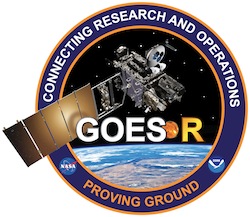
This is part of a project called GOES-R (Geostationary Operational Environmental Satellite R-Series). Here is its stated mission as described on the GOES-R website:
The advanced spacecraft and instrument technology used on the GOES-R series will result in more timely and accurate weather forecasts. It will improve support for the detection and observations of meteorological phenomena and directly affect public safety, protection of property, and ultimately, economic health and development.
GOES-R provides essential information related to air quality, coastal and marine monitoring, fire monitoring, hurricane forecasts, precipitation and floods, land cover observations, volcanoes, lightning detection, severe thunderstorms, tornado warnings and more. If you’re interested in learning more about this project and the advances it will deliver, I highly recommend checking out the GOES-R site. Here are some fun facts I learned in just a few minutes of browsing:
- The instruments on the GOES-R series will produce more than 50 times the information provided by the current GOES system and will offer unique observations of the environment, with emphasis on hazardous weather in the western hemisphere and space weather impacts.
- Data provided by the GOES-R instruments will be used to create 65 different products that meteorologists can use to monitor the weather.
- Information from the GOES-R satellite will improve short-term weather forecasts such as severe thunderstorms and tornadoes, as well as long-term climatological trends.
- GOES-R will be the first of a new fleet of GOES satellites (R/S), marking the first significant upgrade in GOES weather monitoring capabilities since the start of the GOES I/M series in 1994.
- The GOES-R Advanced Baseline Imager (ABI), a sixteen channel imager with two visible channels, four near-infrared channels, and ten infrared channels, will provide three times more spectral information, four times the spatial resolution, and more than five times faster temporal coverage, than the current system.
- The Geostationary Lightning Mapper (GLM) is an optical transient detector and imager that provides early indication of storm intensification and severe weather events, tornado warning lead time of 20 minutes or more and data for long-term climate variability studies.
- Solar UV Imager (SUVI) locates coronal holes, flares and coronal mass ejection source regions. SUVI data characterizes active region complexity, enabling improved forecasting of space weather and early warnings of possible impacts to the Earth environment.
- Space Environmental In-Situ Suite (SEISS) is an ensemble of electron, proton and heavy ion detecting sensors. SEISS data drives the Solar Radiation Storm portion of NOAA’s Space Weather Scales and other NOAA operational Alerts and Warnings.
- Extreme UV/X-ray Irradiance Sensor (EXIS) detects solar soft X-ray irradiance (XRS) and solar Extreme UltraViolet (EUVS) spectral irradiance in the 5-127 nm range. XRS monitors solar flares (and helps predict proton events) that can disrupt communications and degrade navigational accuracy. EUVS monitors solar variations that directly affect satellite drag/tracking and ionospheric changes, which impact communication and navigation operations.
- The magnetometer measures the time-varying field in the magnetosphere. It provides the only operational measure of the impact of geomagnetic storms at geosynchronous orbit, and it is key for interpreting solar radiation storm measurements by SEISS.
Explore other posts from category: Use Cases

 Larry Neumann
Larry Neumann
